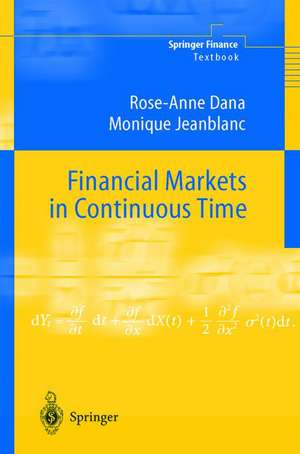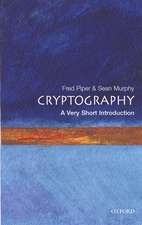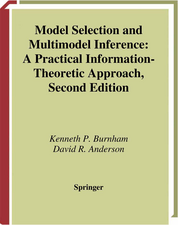Financial Markets in Continuous Time: Springer Finance
Autor Rose-Anne Dana Traducere de A. Kennedy Autor Monique Jeanblancen Limba Engleză Hardback – 26 noi 2002
| Toate formatele și edițiile | Preț | Express |
|---|---|---|
| Paperback (1) | 391.22 lei 6-8 săpt. | |
| Springer Berlin, Heidelberg – 12 iul 2007 | 391.22 lei 6-8 săpt. | |
| Hardback (1) | 398.15 lei 6-8 săpt. | |
| Springer Berlin, Heidelberg – 26 noi 2002 | 398.15 lei 6-8 săpt. |
Din seria Springer Finance
- 13%
 Preț: 359.67 lei
Preț: 359.67 lei - 24%
 Preț: 703.47 lei
Preț: 703.47 lei - 18%
 Preț: 787.15 lei
Preț: 787.15 lei - 19%
 Preț: 501.62 lei
Preț: 501.62 lei - 24%
 Preț: 809.77 lei
Preț: 809.77 lei - 17%
 Preț: 361.15 lei
Preț: 361.15 lei - 24%
 Preț: 605.30 lei
Preț: 605.30 lei - 17%
 Preț: 398.82 lei
Preț: 398.82 lei - 15%
 Preț: 649.06 lei
Preț: 649.06 lei - 18%
 Preț: 937.37 lei
Preț: 937.37 lei - 15%
 Preț: 659.85 lei
Preț: 659.85 lei - 18%
 Preț: 801.17 lei
Preț: 801.17 lei -
 Preț: 387.75 lei
Preț: 387.75 lei - 18%
 Preț: 1108.36 lei
Preț: 1108.36 lei - 15%
 Preț: 651.19 lei
Preț: 651.19 lei - 15%
 Preț: 658.88 lei
Preț: 658.88 lei - 18%
 Preț: 1112.60 lei
Preț: 1112.60 lei - 18%
 Preț: 937.86 lei
Preț: 937.86 lei -
 Preț: 418.34 lei
Preț: 418.34 lei - 15%
 Preț: 597.01 lei
Preț: 597.01 lei - 15%
 Preț: 637.89 lei
Preț: 637.89 lei - 18%
 Preț: 939.62 lei
Preț: 939.62 lei - 15%
 Preț: 632.19 lei
Preț: 632.19 lei - 18%
 Preț: 737.26 lei
Preț: 737.26 lei -
 Preț: 385.84 lei
Preț: 385.84 lei - 18%
 Preț: 892.90 lei
Preț: 892.90 lei -
 Preț: 395.25 lei
Preț: 395.25 lei - 15%
 Preț: 497.45 lei
Preț: 497.45 lei - 15%
 Preț: 644.95 lei
Preț: 644.95 lei - 18%
 Preț: 1207.45 lei
Preț: 1207.45 lei - 18%
 Preț: 810.81 lei
Preț: 810.81 lei -
 Preț: 391.61 lei
Preț: 391.61 lei - 19%
 Preț: 506.25 lei
Preț: 506.25 lei - 18%
 Preț: 957.62 lei
Preț: 957.62 lei -
 Preț: 387.75 lei
Preț: 387.75 lei - 15%
 Preț: 503.37 lei
Preț: 503.37 lei - 15%
 Preț: 593.91 lei
Preț: 593.91 lei -
 Preț: 383.71 lei
Preț: 383.71 lei
Preț: 398.15 lei
Nou
Puncte Express: 597
Preț estimativ în valută:
76.18€ • 79.54$ • 63.05£
76.18€ • 79.54$ • 63.05£
Carte tipărită la comandă
Livrare economică 05-19 aprilie
Preluare comenzi: 021 569.72.76
Specificații
ISBN-13: 9783540434030
ISBN-10: 3540434038
Pagini: 340
Ilustrații: XII, 324 p.
Dimensiuni: 155 x 235 x 24 mm
Greutate: 0.65 kg
Ediția:2003
Editura: Springer Berlin, Heidelberg
Colecția Springer
Seriile Springer Finance, Springer Finance Textbooks
Locul publicării:Berlin, Heidelberg, Germany
ISBN-10: 3540434038
Pagini: 340
Ilustrații: XII, 324 p.
Dimensiuni: 155 x 235 x 24 mm
Greutate: 0.65 kg
Ediția:2003
Editura: Springer Berlin, Heidelberg
Colecția Springer
Seriile Springer Finance, Springer Finance Textbooks
Locul publicării:Berlin, Heidelberg, Germany
Public țintă
ResearchCuprins
The Discrete Case.- Dynamic Models in Discrete Time.- The Black-Scholes Formula.- Portfolios Optimizing Wealth and Consumption.- The Yield Curve.- Equilibrium of Financial Markets in Discrete Time.- Equilibrium of Financial Markets in Continuous Time. The Complete Markets Case.- Incomplete Markets.- Exotic Options.
Recenzii
From the reviews:
This is a high-level but well-written summary of the modern essentials of mathematical finance, including excellent chapters on the yield curve, pricing interest rate products, exotic options and incomplete markets.
D. L. McLeish, Short Book Reviews, December 2003
"Financial Markets in Continuous Time is a well-written textbook for graduate students in mathematical finance. … Graduate students in finance, mathematics, financial engineering, and risk management would benefit from the book in grasping the key financial concepts, mathematical tools, and theories of this discipline. … This book … covers the most important advances in mathematical finance that form the foundation for much of the continuing growth of the discipline." (Thomas S. Y. Ho, SIAM Review, Vol. 46 (3), 2004)
"Dana and Jeanblanc have successfully converted a finance problem into a completely mathematical form. … This book is suited to advanced mathematics students who want to develop mathematics within the framework of finance. … This book looks like mathematics dressed with some financial terms. However, this dressing is so nice that each chapter sounds really interesting. … I would like to recommend this book to postgraduate students or researchers in mathematics or theoretical physics when they want to re-direct their research in finance." (Myungshik Kim, Bulletin of the Irish Mathematical Society, Vol. 51, 2003)
"The objective of this book is to develop the continuous time theory of the valuation of asset prices and the theory of equilibrium of financial markets. … This is a high-level but well-written summary of the modern essentials of mathematical finance, including excellent chapters on the yield curve, pricing interest rate products, exotic options and incomplete markets." (D.L. McLeish, Short Book Reviews, Vol. 23 (3), 2003)
"This book gives an introduction to the theory of financial markets andits applications for the pricing and hedging of financial instruments. For an introductory text, the range of topics covered is amazingly broad. … Many ideas and concepts are first introduced and studied in very simple discrete models, and it is particularly remarkable how many interesting developments are already explained in the first chapter … . The material is chosen well and covers a considerable part of the subject area … . " (Martin Schweizer, Zentralblatt MATH, Vol.1014, 2003)
This is a high-level but well-written summary of the modern essentials of mathematical finance, including excellent chapters on the yield curve, pricing interest rate products, exotic options and incomplete markets.
D. L. McLeish, Short Book Reviews, December 2003
"Financial Markets in Continuous Time is a well-written textbook for graduate students in mathematical finance. … Graduate students in finance, mathematics, financial engineering, and risk management would benefit from the book in grasping the key financial concepts, mathematical tools, and theories of this discipline. … This book … covers the most important advances in mathematical finance that form the foundation for much of the continuing growth of the discipline." (Thomas S. Y. Ho, SIAM Review, Vol. 46 (3), 2004)
"Dana and Jeanblanc have successfully converted a finance problem into a completely mathematical form. … This book is suited to advanced mathematics students who want to develop mathematics within the framework of finance. … This book looks like mathematics dressed with some financial terms. However, this dressing is so nice that each chapter sounds really interesting. … I would like to recommend this book to postgraduate students or researchers in mathematics or theoretical physics when they want to re-direct their research in finance." (Myungshik Kim, Bulletin of the Irish Mathematical Society, Vol. 51, 2003)
"The objective of this book is to develop the continuous time theory of the valuation of asset prices and the theory of equilibrium of financial markets. … This is a high-level but well-written summary of the modern essentials of mathematical finance, including excellent chapters on the yield curve, pricing interest rate products, exotic options and incomplete markets." (D.L. McLeish, Short Book Reviews, Vol. 23 (3), 2003)
"This book gives an introduction to the theory of financial markets andits applications for the pricing and hedging of financial instruments. For an introductory text, the range of topics covered is amazingly broad. … Many ideas and concepts are first introduced and studied in very simple discrete models, and it is particularly remarkable how many interesting developments are already explained in the first chapter … . The material is chosen well and covers a considerable part of the subject area … . " (Martin Schweizer, Zentralblatt MATH, Vol.1014, 2003)
Textul de pe ultima copertă
In modern financial practice, asset prices are modelled by means of stochastic processes, and continuous-time stochastic calculus thus plays a central role in financial modelling. This approach has its roots in the foundational work of the Nobel laureates Black, Scholes and Merton. Asset prices are further assumed to be rationalizable, that is, determined by equality of demand and supply on some market. This approach has its roots in the foundational work on General Equilibrium of the Nobel laureates Arrow and Debreu and in the work of McKenzie. This book has four parts. The first brings together a number of results from discrete-time models. The second develops stochastic continuous-time models for the valuation of financial assets (the Black-Scholes formula and its extensions), for optimal portfolio and consumption choice, and for obtaining the yield curve and pricing interest rate products. The third part recalls some concepts and results of general equilibrium theory, and applies this in financial markets. The last part is more advanced and tackles market incompleteness and the valuation of exotic options in a complete market.
Caracteristici
Explains key financial concepts, mathematical tools and theories of mathematical finance Range of topics covered is very broad for an introductory text Contains two separate appendices on Brownian motion and on numerical methods Includes supplementary material: sn.pub/extras
















